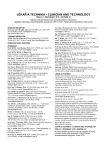-
Články
- Časopisy
- Kurzy
- Témy
- Kongresy
- Videa
- Podcasty
STRUCTURED PDMS USED AS ACTIVE ELEMENT FOR A BIOMIMETICS INSPIRED FLUID TRANSPORTER
A pneumatically actuated fluid transporter to transport fluids along surfaces is introduced. The biomimetic approach is based on the transportation principle of fluids by cilia or comb-row arrays due to the generation of metachronal waves. Rows of PDMS flaps which mimic comb-rows are asymmetrically positioned on flexible membranes. Each membrane is deflected by applying a defined pressure profile to achieve a metachronal wave on the surface. The simulations of the membrane behavior as well as a description of the concept by applying metachronal waves to the artificial comb row arrays are presented. The proof-of-concept shows fluid transport of up to 64 µm/s near the flap tips.
Keywords:
PDMS, microfluidics, fluid transport, particle transport, biomimetics, cilia
Autoři: Alexander Rockenbach; Uwe Schnakenberg
Působiště autorů: Institute of Materials in Electrical Engineering 1, RWTH Aachen University, Aachen, Germany
Vyšlo v časopise: Lékař a technika - Clinician and Technology No. 2, 2015, 45, 37-41
Kategorie: Původní práce
Souhrn
A pneumatically actuated fluid transporter to transport fluids along surfaces is introduced. The biomimetic approach is based on the transportation principle of fluids by cilia or comb-row arrays due to the generation of metachronal waves. Rows of PDMS flaps which mimic comb-rows are asymmetrically positioned on flexible membranes. Each membrane is deflected by applying a defined pressure profile to achieve a metachronal wave on the surface. The simulations of the membrane behavior as well as a description of the concept by applying metachronal waves to the artificial comb row arrays are presented. The proof-of-concept shows fluid transport of up to 64 µm/s near the flap tips.
Keywords:
PDMS, microfluidics, fluid transport, particle transport, biomimetics, cilia
Zdroje
[1] Squires TM, “Microfluidics : Fluid physics at the nanoliter scale,” Rev. Mod. Phys., vol. 77, no. July, pp. 977–1016, 2005.
[2] Wu D et al., “Electrophoretic separations on microfluidic chips.” J. Chromatogr. A, vol. 1184, no. 1–2, pp. 542–59, Mar. 2008.
[3] Markx GH and Davey CL, “The dielectric properties of biological cells at radiofrequencies: applications in biotechnology,” Enzyme Microb. Technol., vol. 25, no. 3–5, pp. 161–171, Aug. 1999.
[4] Friend J and Yeo LY, “Microscale acoustofluidics: Microfluidics driven via acoustics and ultrasonics,” Rev. Mod. Phys., vol. 83, no. 2, pp. 647–704, Jun. 2011.
[5] Osterman N and Vilfan A, “Finding the ciliary beating pattern with optimal efficiency.,” Proc. Natl. Acad. Sci. U. S. A., vol. 108, no. 38, pp. 15727–32, Sep. 2011.
[6] Alexeev A et al., “Designing synthetic, pumping cilia that switch the flow direction in microchannels,” Langmuir, vol. 24, no. 21, pp. 12102–12106, 2008.
[7] Vilfan M et al., “Self-assembled artificial cilia.,” Proc. Natl. Acad. Sci. U. S. A., vol. 107, no. 5, pp. 1844–7, Feb. 2010.
[8] Timonen JVI et al., “A facile template-free approach to magnetodriven, multifunctional artificial cilia.” ACS Appl. Mater. Interfaces, vol. 2, no. 8, pp. 2226–30, Aug. 2010.
[9] Gao Y et al., “Strong vortical flows generated by the collective motion of magnetic particle chains rotating in a fluid cell.” Lab Chip, Nov. 2014.
[10] den Toonder JMJ and Onck PR, “Microfluidic manipulation with artificial/bioinspired cilia.” Trends Biotechnol., vol. 31, no. 2, pp. 85–91, Feb. 2013.
[11] Khaderi SN et al., “Magnetically-actuated artificial cilia for microfluidic propulsion.” Lab Chip, vol. 11, no. 12, pp. 2002–10, Jun. 2011.
[12] van Oosten CL et al., “Printed artificial cilia from liquid-crystal network actuators modularly driven by light.” Nat. Mater., vol. 8, no. 8, pp. 677–682, Aug. 2009.
[13] Zarzar LD et al., “Bio-inspired design of submerged hydrogel-actuated polymer microstructures operating in response to pH.,” Adv. Mater., vol. 23, no. 12, pp. 1442–6, Mar. 2011.
[14] Sanchez T et al., “Cilia-like beating of active microtubule bundles.” Science, vol. 333, no. 6041, pp. 456–9, Jul. 2011.
[15] Dayal P et al., “Chemically-mediated communication in self-oscillating, biomimetic cilia,” J. Mater. Chem., vol. 22, no. 1, p. 241, 2012.
[16] Brücker C and Keissner A, “Streaming and mixing induced by a bundle of ciliary vibrating micro-pillars,” Exp. Fluids, vol. 49, no. 1, pp. 57–65, Nov. 2009.
[17] Rockenbach A et al., “Pneumatically Actuated Biomimetic Particle Transporter,” in 2014 IEEE 27th International Conference on Micro Electro Mechanical Systems (MEMS 2014), 2014, pp. 927–930.
[18] Rockenbach A et al., “Fluid transport via pneumatically actuated waves on a ciliated wall,” J. Micromechanics Microengineering, vol. 25, no. 12, p. 125009, 2015.
[19] Klammer I et al., “Numerical analysis and characterization of bionic valves for microfluidic PDMS-based systems,” J. Micromechanics Microengineering, vol. 17, no. 7, pp. S122–S127, Jul. 2007.
[20] Khaderi SN et al., “Magnetically-actuated artificial cilia for microfluidic propulsion.” Lab Chip, vol. 11, no. 12, pp. 2002–2010, Jun. 2011.
[21] Goldstein R et al., “Noise and Synchronization in Pairs of Beating Eukaryotic Flagella,” Phys. Rev. Lett., vol. 103, no. 16, p. 168103, Oct. 2009.
[22] Dauptain A et al., “Hydrodynamics of Beating Cilia,” Symp. A Q. J. Mod. Foreign Lit., pp. 1–10, 2007.
[23] Brennen C and Winet H, “Fluid Mechanics of Propulsion by Cilia and Flagella,” Annu. Rev. Fluid Mech., vol. 9, pp. 339–98, 1977.
Štítky
Biomedicína
Článok vyšiel v časopiseLékař a technika

2015 Číslo 2-
Všetky články tohto čísla
- STRUCTURED PDMS USED AS ACTIVE ELEMENT FOR A BIOMIMETICS INSPIRED FLUID TRANSPORTER
- New Algorithm for EEG and EMG Separation
- Detection of facial areas in ThERMAL IMAGES
- MODELING OF THE CHEMICAL STAGE OF RADIOBIOLOGICAL MECHANISM USING PETRI NETS
- Použití radiochromního gelového dozimetru pro verifikaci dávkové distribuce ve stereotaktické radiochirurgii
- Lékař a technika
- Archív čísel
- Aktuálne číslo
- Informácie o časopise
Najčítanejšie v tomto čísle- Použití radiochromního gelového dozimetru pro verifikaci dávkové distribuce ve stereotaktické radiochirurgii
- STRUCTURED PDMS USED AS ACTIVE ELEMENT FOR A BIOMIMETICS INSPIRED FLUID TRANSPORTER
- New Algorithm for EEG and EMG Separation
- Detection of facial areas in ThERMAL IMAGES
Prihlásenie#ADS_BOTTOM_SCRIPTS#Zabudnuté hesloZadajte e-mailovú adresu, s ktorou ste vytvárali účet. Budú Vám na ňu zasielané informácie k nastaveniu nového hesla.
- Časopisy



